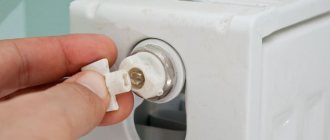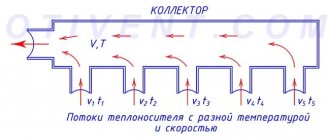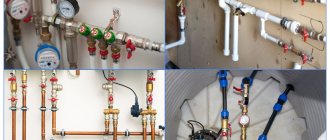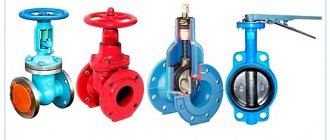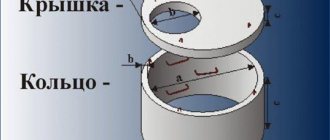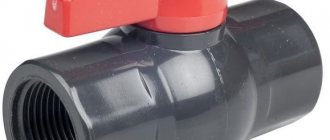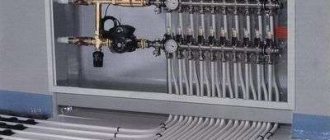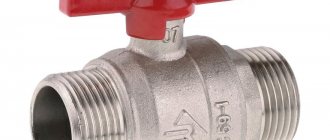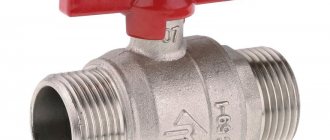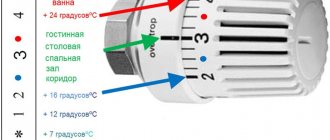Water taps of various designs are found in every home. I don’t really want to call in a plumber every time the faucet breaks, do you agree? But in order to cope with the repair, you need to know the design of a ball-type water tap and its main parts.
This is where we will come to your aid - this article discusses the existing types of ball valves, their design, classification, marking features and operating principle. Thanks to the knowledge gained, you will be able to handle all types of repairs yourself.
For a better understanding of the material, we provided the article with visual photos and diagrams showing the design of a valve with a ball mechanism, and also selected videos that provide information in an accessible form on how to turn off and install the valve.
Design and principle of operation
The body of the shut-off device is a piece of pipe expanded in the middle part. The extension contains a seat made of sealing material, inside of which there is the main element - a ball, also known as a valve or plug.
The ball can rotate freely inside the seat. It has only one through hole in the shut-off valve.
Control devices and valves that redirect flow may have 2 or 3 holes. If the tap is used to regulate the pressure of hot or cold water, then there are two holes, if the device is a mixer, then there are three holes.
The ball valve is activated by turning a lever to which a ball valve with a hole is connected through a rod. By rotating the hole relative to the axis of the pipeline, we open/close the passage of the medium or partially let it through
The principle of operation is very simple: when the axis of the hole in the ball is aligned with the axis of the faucet body, water will begin to flow out of it.
Those. when the plug is deployed so that its hole coincides with the direction of the pipeline, as if continuing it. In this position, the flow of liquid, steam, gas passes through the pipeline, including through the tap, freely.
When the ball valve is turned 90º, the passage for water, steam, gas is blocked by the side on which there are no holes. In this position, the flow of the medium stops completely, because it rests against the solid wall of the valve.
However, with this simple device you can regulate the flow parameters. When turning 45º, for example, the flow will only be blocked by half.
To control the ball, a rod connected to a lever is used. There are o-rings on both sides of the rod. The hole in the body through which the rod passes is also equipped with a washer and an O-ring.
The single-lever ball mixer is equipped with a valve with two holes for the passage of cold and hot water and another hole for the exit of a mixed stream
Ball valves are made of brass or various grades of steel. Brass devices are considered more reliable, their service life exceeds 10 years. Steel products are very rarely used in everyday life; they are mainly used for industrial pipeline systems.
More recently, manufacturers began to produce cranes whose body is made of high-strength plastic. Unlike brass, such devices are not subject to corrosion and are much cheaper.
The only disadvantage of plastic products is that they cannot be used for hot water.
All o-rings are made of high-density rubber; these are the “weakest” points of the faucet, which cause leaks, but are easily replaced using a regular repair kit
These taps are most widely used in everyday life. A feature of their design is that the ball is not rigidly connected to the stem and can move under the influence of water, pressing against the sealing ring, thus sealing the tap.
A floating ball is used in mechanisms whose nominal size does not exceed 20 cm. Such devices are installed in internal water and heat supply systems. Almost all domestic and imported household faucets also have a floating ball mechanism.
The design of the valve body with a floating ball can be either welded or dismountable. Sealing elements can be of different hardness. Small household appliances are usually collapsible and have soft seals.
Floating valves are installed on pipelines with a diameter of up to 200 mm with constant movement of the working medium. The ball, under the pressure of the medium, is pressed against the sealing rings, sealing the fittings
There are valves in which the locking element is fixed on the axis of the stem, and the seals are pressed against the ball using tightening bolts or springs. To facilitate closing/opening, the trunnion is equipped with bearings.
This design is the most reliable, but due to its high cost it is used extremely rarely in everyday life and usually in the most critical areas of the water supply system.
Tips for choosing
Almost the entire choice of the best ball valves for the home comes down to brass products - reliable, non-corrosive, durable, inexpensive and widespread. On polypropylene pipes, polypropylene structures are used to disconnect part of the system. Metal products are always placed at the input.
Leaking water systems are expensive, so you should buy products in fairly large stores, with a receipt and certificate. Do not focus on imported products - domestic manufacturers also produce good quality products.
The tap must be inspected - there should be no chips or cracks; the thread must have at least 4-6 full turns without nicks; the walls must be thick enough; it is necessary to inspect the inside of the faucet, check how the handle and the ball turn, whether there is a hole in the ball (and whether there is a ball - occasionally there are “dummies” in which the body is machined like a pipe, the handle does not turn, there is no ball in sight). In addition, you need to try to understand whether the body is silumin - the metal inside will be white, and the faucet will seem light - the density of silumin is less than that of brass (according to the standard - 8.5-8.7 g/cm³). You can’t buy silumin - sometimes it bursts during installation.
The handle is more reliable and practical than the butterfly handle, but when installing the faucet against a wall or in a cramped bathroom, you should consider whether there is enough space to turn the lever, or whether you should buy a butterfly handle. For the entrance, a faucet with threaded pipes of the “nut-fitting” type is most often chosen.
approximate price
Brass taps with running diameters of 15 and 20 mm cost from 150 rubles, polypropylene taps of the same diameters - from 110 rubles. A lever faucet for a kitchen will cost from 2,000 rubles (the simplest) to... there is no limit to perfection - there are faucets that cost tens of thousands, and for a shower they can reach up to 100,000.
Marking of ball valves
Each manufacturer has its own range of manufactured cranes, but all Russian-made products, as well as imported devices sold in the Russian Federation, comply with GOST 52760 . This standard regulates the marking of shut-off and control equipment, which includes ball valves.
Labeling must include:
- nominal bore (nominal diameter), denoted by the abbreviation DN;
- nominal pressure indicator – PN;
- the value of the design (working) pressure;
- an arrow indicating the direction of water movement;
- maximum operating temperature;
- release date.
In accordance with GOST 4666, devices made of cast iron are painted black, and those made of stainless steel are painted blue. Taps for hot water are marked in red.
Today, more than four thousand standard sizes of taps are produced for various needs; small-diameter devices are used in domestic water supply systems
Installation and operating rules
The design of the ball water tap makes it easy to install it yourself where it is required. The crane must be mounted in a place so that during operation it does not interfere or is not subject to mechanical stress.
At the same time, unimpeded access to the crane must be ensured in case of control of operation, correction of repairable damage and dismantling if replacement is necessary.
The locking device is installed on metal or plastic pipes according to the following algorithm:
- The old faucet (if any) is removed and the threads are cleaned of any remaining tow and sealant.
- The threaded seal is wound tightly.
- A new, appropriately sized locking device is screwed on. Please note that the thread on which the product is screwed must not be rotten; it must have at least four turns. Otherwise, it is necessary to replace the entire pipe or part of it.
When installing a water supply system from scratch, first of all, you need to mark the place where the tap will be installed. Then the pipe is cut at this place, a corresponding thread is made, onto which the locking device is screwed.
To cut pipes, special equipment is used - a pipe cutter. But you can also use improvised tools, although it is not so convenient, and the cut will not be as even and smooth. You can read more about choosing a pipe cutter for copper pipes in this article.
Do you have a water supply system made of metal-plastic pipes? You can read about the types of pipe cutters for such a pipeline in our other article.
In both cases, before installation you need to pay attention to the arrow indicating the direction of flow and be sure to comply with this condition. Before screwing the faucet, it is recommended to wrap the thread with FUM tape. This will ensure the most reliable sealing.
After installation, it is necessary to check the functionality of the locking device. To do this, you need to turn on the water and check for leaks, gradual formation of drops, or smudges. It is also necessary to make sure that nothing interferes with the control of the crane, i.e. the lever or “butterfly” has free movement.
To install the device using the welding method, electric welding is used. During the welding process, it is important not to damage the ball mechanism and o-rings.
First, one pipe is welded, then the second, while on vertical sections the valve should be installed in the “closed” position, and on horizontal sections – “open”.
Using a fitting and a lock nut, a ball valve can be installed not only on a metal or plastic pipe, but also to connect pipes from different materials.
The operation of ball mechanisms does not cause difficulties; they are used either closed or open. It is theoretically possible to regulate water supply using a ball valve.
However, it is worth considering that such a faucet is, first of all, a shut-off device and too intensive use will lead to rapid wear of the seals. To regulate the flow, it is better to use ball mixers or a needle valve if it is impossible to install a mixer.
Do not install household taps where process water containing solid impurities passes through the pipes, because they will quickly damage the O-rings, rendering the locking device inoperable.
Before purchasing ball control valves for water supply installation, you need to check the plan and determine how many straight-through and rotary pieces will be required
conclusions
In addition to the main varieties and modifications of ball devices listed above, there is special-purpose equipment for which standard mechanisms are not suitable. This could be a device for releasing air from the heating main, where a Mayevsky mechanism with a drain valve is installed, ball valves with a fine filter, which are used to deliver clean water to water collection points, etc. Having studied in detail the classification and categories of all types of ball valves, having become familiar with all the positive and negative sides, you can choose equipment for installation in the communication circuit.
Advantages and disadvantages of ball valves
Ball valves are very popular in a wide variety of industries. They are considered reliable shut-off devices and are part of the water supply system of city apartments and private houses.
In addition to reliability and simplicity of design, products of this type have many other advantages:
- long working life, long service life;
- rarely break down, easy to repair;
- high degree of tightness; if installed correctly, there are no leaks;
- convenient to use, turning or pressing the lever is enough to shut off the water flow;
- a huge range of sizes and types;
- Easy to install, you can install it yourself without involving a plumber.
Ball valves have no disadvantages, they are affordable, and every hardware store will offer you a choice of several products of various sizes.
A mixer with a ball mechanism will relieve its owners from labor-intensive and frequent replacement of gaskets, as well as problems with water leakage, which are so often found with outdated valve taps.
Ball mixers very rarely fail; the main cause of failure is hard water, so manufacturers recommend installing water filters in the water supply system
Purpose
Ball valves are new generation locking mechanisms with their own distinctive features and different areas of use. These universal devices can be used on pipes with different diameters. The device is used in water systems to move liquid and gaseous substances.
Water ball valves are necessary in drainage systems, heating systems and urban utility systems. They are also used as one of the fittings for regulating water pressure. They are indispensable in the entire pipeline system. More often than other areas, they are used in the installation of equipment for plumbing and heating, gas pipelines and water supply systems.
The use of ball valves is possible in a wide range of temperatures in environments with varying degrees of aggressiveness. This quality is due to the use of high-quality steel alloys in the manufacture of this type of equipment. These cranes gradually became leaders in application.
How to choose a good ball valve?
As already mentioned, modern manufacturers produce more than 4 thousand different types of ball valves, so for an unprepared buyer choosing a shut-off device is a difficult task.
When choosing a mechanism, in addition to the main parameter – the throughput diameter, you should pay attention to the following factors:
- Appearance. A high-quality product has no chips, nicks, or dents. Its surface is smooth, the manufacturer's markings are clearly visible.
- Permissible pressure. Of the two options, it is better to choose the valve with the maximum allowable pressure, which will be greater. Please note that this indicator for hot water must be at least 20 kg/cm², for cold water - at least 10 kg/cm². The higher the permissible pressure, the better the product will withstand water hammer in the water supply and heating systems that periodically occur in the pipeline.
- Execution of the case . To connect household appliances, shower cabins, install a water supply system inside a house or install pipes in an apartment, it is better to give preference to simpler and more repairable collapsible taps. For the most important areas, such as a central water supply, the best option would be an all-welded housing.
- Case material. The highest quality products are made from brass. Be careful! Under the guise of a brass faucet, they may sell you a fake made of silumin, a cheap, low-quality metal. You can tell a fake by its weight: the brass faucet is heavy.
Steel products look solid, but quickly rust and fail. Of course, this does not apply to stainless steel devices, which, however, are quite rare. If only cold water will flow through the tap, then you can choose a plastic product.
To shut off the flow in free-flow and low-pressure systems transporting drinking water, household non-caustic and storm drains, ball valves made of unplasticized PVC can be used
When choosing a faucet, focus on the average price; too low a price should alert you, because... You are probably being offered a defective or counterfeit product made from cheap steel.
As for the cost of ball valves, the most expensive are Made in Italy devices. Spanish, Czech, and Hungarian devices are slightly lower in cost. Russian and Ukrainian manufacturers occupy an average price niche, combining quality and reasonable cost.
The most expensive and durable ball valves are made of brass, coated with a chrome or nickel layer; such devices can be operated for a long time at temperatures above one hundred degrees
The cheapest products are traditionally made in China. The quality of Chinese mechanisms leaves much to be desired; they can only be used as temporary locking devices.
Design
- frame
- saddle
- ball plug (ball)
- O-rings
- lever arm
- stock
- washer
The body is a piece of pipe with an extension. The body is manufactured in a collapsible type and a non-separable welded type. Collapsible cranes fail more often than others, but are easier to repair. Industrial taps are made of steel, while household taps are made of brass.
Recently, plastic products have begun to go on sale for household use. The expansion of the body is filled with a saddle. It is made from sealing material.
